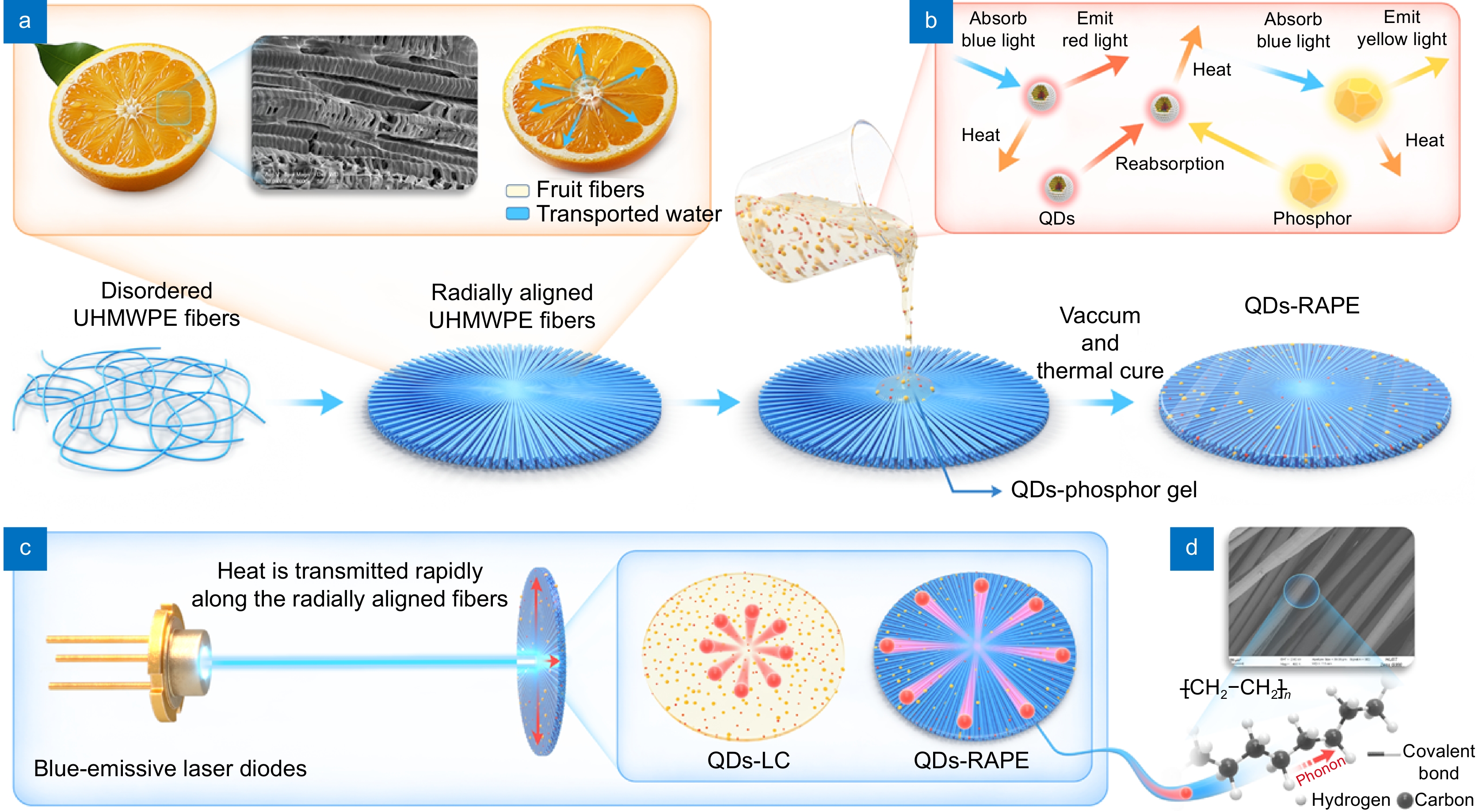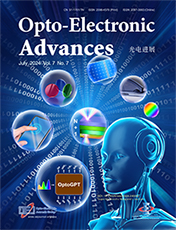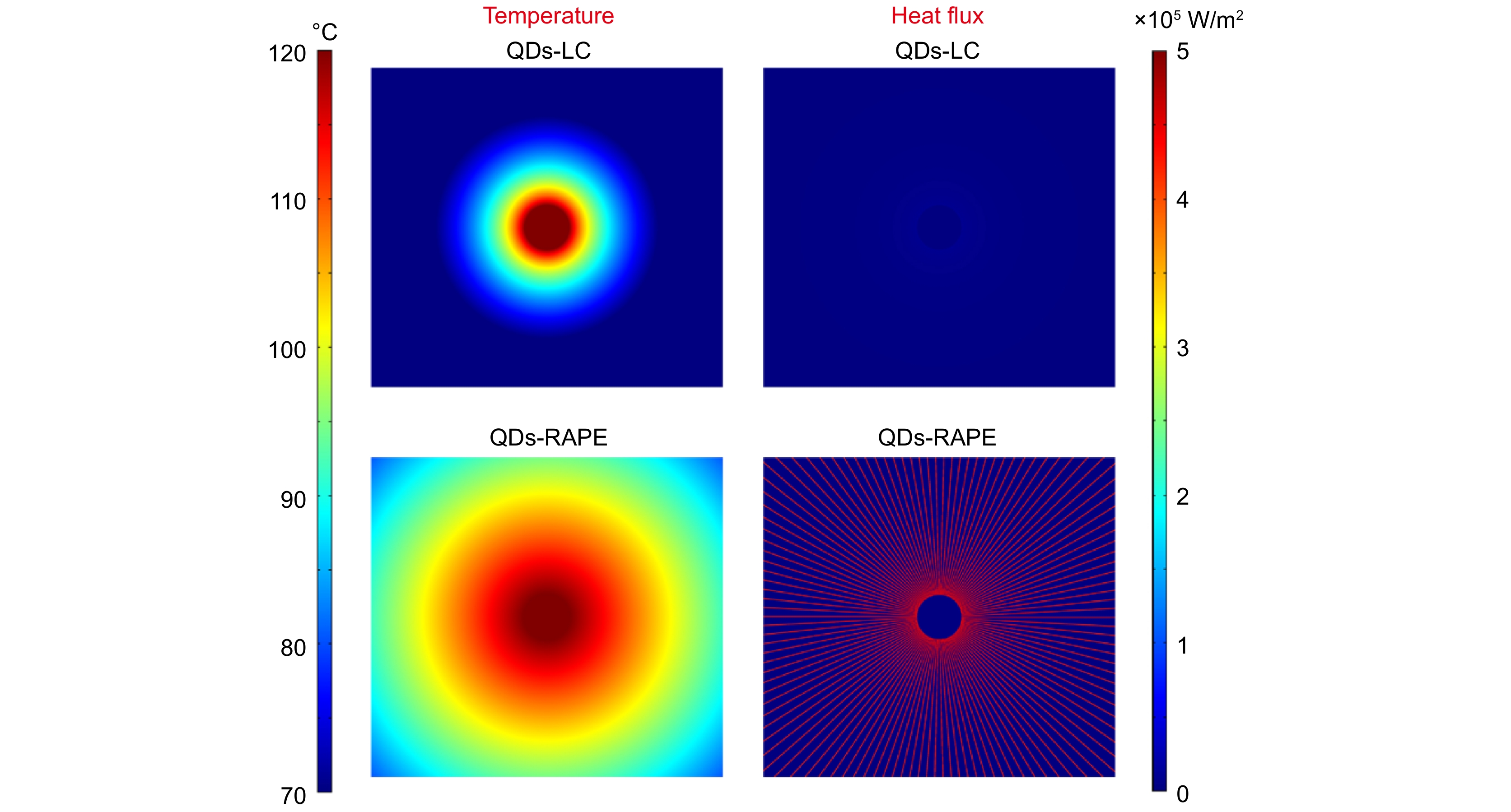| Citation: | Yang X, Zhang XF, Zhang TX et al. Paving continuous heat dissipation pathways for quantum dots in polymer with orange-inspired radially aligned UHMWPE fibers. Opto-Electron Adv 7, 240036 (2024). doi: 10.29026/oea.2024.240036 |
Paving continuous heat dissipation pathways for quantum dots in polymer with orange-inspired radially aligned UHMWPE fibers
-
Abstract
Thermal management of nanoscale quantum dots (QDs) in light-emitting devices is a long-lasting challenge. The existing heat transfer reinforcement solutions for QDs-polymer composite mainly rely on thermal-conductive fillers. However, this strategy failed to deliver the QDs’ heat generation across a long distance, and the accumulated heat still causes considerable temperature rise of QDs-polymer composite, which eventually menaces the performance and reliability of light-emitting devices. Inspired by the radially aligned fruit fibers in oranges, we proposed to eliminate this heat dissipation challenge by establishing long-range ordered heat transfer pathways within the QDs-polymer composite. Ultrahigh molecular weight polyethylene fibers (UPEF) were radially aligned throughout the polymer matrix, thus facilitating massive efficient heat dissipation of the QDs. Under a UPEF filling fraction of 24.46 vol%, the in-plane thermal conductivity of QDs-radially aligned UPEF composite (QDs-RAPE) could reach 10.45 W m−1 K−1, which is the highest value of QDs-polymer composite reported so far. As a proof of concept, the QDs’ working temperature can be reduced by 342.5 °C when illuminated by a highly concentrated laser diode (LD) under driving current of 1000 mA, thus improving their optical performance. This work may pave a new way for next generation high-power QDs lighting applications.-
Keywords:
- quantum dots /
- UHMWPE fibers /
- radial alignment /
- heat dissipation /
- light-emitting devices
-

-
References
[1] Maheshwaran A, Bae H, Park J et al. Low-temperature cross-linkable hole transport materials for solution-processed quantum dot and organic light-emitting diodes with high efficiency and color purity. ACS Appl Mater Interfaces 15, 45167–45176 (2023). doi: 10.1021/acsami.3c09106 [2] Zhang H Y, Wang B L, Niu Z J et al. Ultrasmall water-stable CsPbBr3 quantum dots with high intensity blue emission enabled by zeolite confinement engineering. Mater Horiz 10, 5079–5086 (2023). doi: 10.1039/D3MH01092A [3] Almeida G, van der Poll L, Evers WH et al. Size-dependent optical properties of InP colloidal quantum dots. Nano Lett 23, 8697–8703 (2023). doi: 10.1021/acs.nanolett.3c02630 [4] Liao ZB, Mallem K, Prodanov MF et al. Ultralow roll-off quantum dot light-emitting diodes using engineered carrier injection layer. Adv Mater 35, 2303950 (2023). doi: 10.1002/adma.202303950 [5] Ding SS, Steele JA, Chen P et al. Ligand‐mediated homojunction structure for high‐efficiency FAPbI3 quantum dot solar cells. Adv Energy Mater 13, 2301817 (2023). doi: 10.1002/aenm.202301817 [6] Kong MQ, Osvet A, Barabash A et al. AgIn5S8/ZnS quantum dots for luminescent down-shifting and antireflective layer in enhancing photovoltaic performance. ACS Appl Mater Interfaces 115, 52746–52753 (2023). [7] Zhang LX, Mei LY, Wang KY et al. Advances in the application of perovskite materials. Nano-Micro Lett 15, 177 (2023). doi: 10.1007/s40820-023-01140-3 [8] Arya S, Jiang YR, Jung BK et al. Understanding colloidal quantum dot device characteristics with a physical model. Nano Lett 23, 9943–9952 (2023). doi: 10.1021/acs.nanolett.3c02899 [9] Đorđević N, Schwanninger R, Yarema M et al. Metasurface colloidal quantum dot photodetectors. ACS Photonics 9, 482–492 (2022). doi: 10.1021/acsphotonics.1c01204 [10] Tian YY, Luo HQ, Chen MY et al. Mercury chalcogenide colloidal quantum dots for infrared photodetection: from synthesis to device applications. Nanoscale 15, 6476–6504 (2023). doi: 10.1039/D2NR07309A [11] Wang YP, Yang YS, Zhang DK et al. Phosphorescent-dye-sensitized quantum-dot light-emitting diodes with 37% external quantum efficiency. Adv Mater 35, 2306703 (2023). doi: 10.1002/adma.202306703 [12] Zhang DQ, Wei CT, Li XS et al. Highly solvent resistant small-molecule hole-transporting materials for efficient perovskite quantum dot light-emitting diodes. ACS Appl Mater Interfaces 15, 44043–44053 (2023). doi: 10.1021/acsami.3c08691 [13] Kakuda M, Morais N, Kwoen J et al. Enhanced temperature stability of threshold current of InAs/GaAs quantum dot lasers by AlGaAs lateral potential barrier layers. Opt Express 31, 31243–31252 (2023). doi: 10.1364/OE.498996 [14] Yang T, Chen YH, Wang YC et al. Green vertical-cavity surface-emitting lasers based on InGaN quantum dots and short cavity. Nano-Micro Lett 15, 223 (2023). doi: 10.1007/s40820-023-01189-0 [15] Jang HS, Yang H, Kim SW et al. White light-emitting diodes with excellent color rendering based on organically capped CdSe quantum dots and Sr3SiO5: Ce3+, Li+ phosphors. Adv Mater 20, 2696–2702 (2008). doi: 10.1002/adma.200702846 [16] Yoon C, Yang KP, Kim J et al. Fabrication of highly transparent and luminescent quantum dot/polymer nanocomposite for light emitting diode using amphiphilic polymer-modified quantum dots. Chem Eng J 382, 122792 (2020). doi: 10.1016/j.cej.2019.122792 [17] Chen KJ, Chen HC, Shih MH et al. The Influence of the thermal effect on CdSe/ZnS quantum dots in light-emitting diodes. J Lightwave Technol 30, 2256–2261 (2012). doi: 10.1109/JLT.2012.2195158 [18] Woo JY, Kim KN, Jeong S et al. Thermal behavior of a quantum dot nanocomposite as a color converting material and its application to white LED. Nanotechnology 21, 495704 (2010). doi: 10.1088/0957-4484/21/49/495704 [19] Zhao YM, Riemersma C, Pietra F et al. High-temperature luminescence quenching of colloidal quantum dots. ACS Nano 6, 9058–9067 (2012). doi: 10.1021/nn303217q [20] Xie B, Liu HC, Hu R et al. Targeting cooling for quantum dots in white QDs-LEDs by hexagonal boron nitride platelets with electrostatic bonding. Adv Funct Mater 28, 1801407 (2018). doi: 10.1002/adfm.201801407 [21] Chang H, Zhong YC, Dong HX et al. Ultrastable low-cost colloidal quantum dot microlasers of operative temperature up to 450 K. Light Sci Appl 10, 60 (2021). doi: 10.1038/s41377-021-00508-7 [22] Moon H, Lee C, Lee W et al. Stability of quantum dots, quantum dot films, and quantum dot light-emitting diodes for display applications. Adv Mater 31, 1804294 (2019). doi: 10.1002/adma.201804294 [23] Li ZT, Li JX, Li JS et al. Thermal impact of LED chips on quantum dots in remote-chip and on-chip packaging structures. IEEE Trans Electron Dev 66, 4817–4822 (2019). doi: 10.1109/TED.2019.2941911 [24] Zheng H, Lei X, Cheng T et al. Enhancing the thermal dissipation of a light-converting composite for quantum dot-based white light-emitting diodes through electrospinning nanofibers. Nanotechnology 28, 265204 (2017). doi: 10.1088/1361-6528/aa72d6 [25] Xu J, Hu BF, Xu C et al. A unique color converter geometry for laser-driven white lighting. Opt Mater 86, 286–290 (2018). doi: 10.1016/j.optmat.2018.10.012 [26] Zheng F, Yang BB, Cao PY et al. A novel bulk phosphor for white LDs: CsPbBr3/Cs4PbBr6 composite quantum dots-embedded borosilicate glass with high PLQY and excellent stability. J Alloys Compd 818, 153307 (2020). doi: 10.1016/j.jallcom.2019.153307 [27] Zhou SL, Ma YP, Zhang XF et al. White-light-emitting diodes from directional heat-conducting hexagonal boron nitride quantum dots. ACS Appl Nano Mater 3, 814–819 (2020). doi: 10.1021/acsanm.9b02321 [28] Yang X, Zhou SL, Xie B et al. Enhancing heat dissipation of quantum dots in high-power white LEDs by thermally conductive composites annular fins. IEEE Electron Device Lett 42, 1204–1207 (2021). doi: 10.1109/LED.2021.3088280 [29] Zhao WX, Xie B, Peng Y et al. Cooling photoluminescent phosphors in laser-excited white lighting with three-dimensional boron nitride networks. Opt Laser Technol 157, 108689 (2023). doi: 10.1016/j.optlastec.2022.108689 [30] Xie B, Wang YJ, Liu HC et al. Targeting cooling for quantum dots by 57.3°C with air-bubbles-assembled three-dimensional hexagonal boron nitride heat dissipation networks. Chem Eng J 427, 130958 (2022). doi: 10.1016/j.cej.2021.130958 [31] Xie YY, Yang DD, Zhang LL et al. Highly efficient and thermally stable QD-LEDs based on quantum dots-SiO2-BN nanoplate assemblies. ACS Appl Mater Interfaces 12, 1539–1548 (2020). doi: 10.1021/acsami.9b18500 [32] Zhang LL, Xie YY, Tian ZZ et al. Thermal conductive encapsulation enables stable high-power perovskite-converted light-emitting diodes. ACS Appl Mater Interfaces 13, 30076–30085 (2021). doi: 10.1021/acsami.1c07194 [33] Wang XW, Wu PY. 3D vertically aligned BNNs network with long-range continuous channels for achieving a highly thermally conductive composite. ACS Appl Mater Interfaces 11, 28943–28952 (2019). doi: 10.1021/acsami.9b09398 [34] Xu YF, Kraemer D, Song B et al. Nanostructured polymer films with metal-like thermal conductivity. Nat Commun 10, 1771 (2019). doi: 10.1038/s41467-019-09697-7 [35] Wang XJ, Kaviany M, Huang BL. Phonon coupling and transport in individual polyethylene chains: a comparison study with the bulk crystal. Nanoscale 9, 18022–18031 (2017). doi: 10.1039/C7NR06216H [36] Xie B, Zhao WX, Luo XB et al. Alignment engineering in thermal materials. Mater Sci Eng R Rep 154, 100738 (2023). doi: 10.1016/j.mser.2023.100738 [37] Henry A, Chen G. Anomalous heat conduction in polyethylene chains: theory and molecular dynamics simulations. Phys Rev B 79, 144305 (2009). doi: 10.1103/PhysRevB.79.144305 -
Supplementary Information
Supplementary information for Paving continuous heat dissipation pathways for quantum dots in polymer with orangeinspired radially aligned UHMWPE fibers 
-
Access History

Article Metrics
-
Figure 1.
Fabrication process of QDs-RAPE. (a) SEM image of fruit fibers of oranges and diagram illustration of water transportation with the radially aligned fruit fibers networks. (b) Light conversion and heat generation process of QDs and phosphor. (c) Schematic of operated transmissive WLDs and comparison of heat dissipation ability of QDs-LC and QDs-RAPE. (d) SEM image and schematic of molecular chains of UPEF.
-
Figure 2.
(a) Photograh of QDs-RAPE. (b) Partial enlarged image of QDs-RAPE under optical microscope. (c−g) SEM images of QDs-RAPE under different magnifications. (h−i) SEM images of QDs-RAPE after removing UPEF under different magnifications. (j) SEM image and corresponding EDS mapping images of QDs-RAPE.
-
Figure 3.
(a) UV-VIS absorption spectra and (b) photoluminescence spectra of QDs-silicone, phosphor-silicone, QDs-LC and QDs-RAPE, respectively. (c) TRPL decay curves of QDs in chloroform, silicone and silicone with radially aligned UPEF, respectively.
-
Figure 4.
Through-plane TC, in-plane TC and anisotropic degree of TC of RA-PE with different UPEF volume ratio, respectively.
-
Figure 5.
Simulated temperature and heat flux distribution of (a) QDs-LC and (b) QDs-RAPE.
-
Figure 6.
Surface temperature distributions of the three samples under driving currents of (a) 700 mA and (b) 1000 mA. (c) Temperature measurement setup. (d) Maximum surface temperature of the samples under different driving currents.
-
Figure 7.
(a) Spectral power distributions and optical properties of QDs-LC, 8.15 vol% and 21.92 vol% QDs-RAPE under driving current of 700 mA. Inset is the photograph of QDs-RAPE with illumination. (b) Spectral power distribution and optical properties of 21.92 vol% QDs-RAPE under driving current of 1500 mA. (c) The coordinates of the luminescent composites in the CIE 1931 diagram. (d) LE, (e) CRI and (f) CCT of QDs-RAPE (8.15, 11.93, 17.70, 21.92 and 26.70 vol%) and QDs-LC under different driving currents from 300 to 1500 mA.
-
Figure 8.
Enhancement ratios of (a) yellow- and (b) red- light intensity of QDs-RAPE to QDs-LC under different driving currents.

 E-mail Alert
E-mail Alert RSS
RSS



 DownLoad:
DownLoad:









